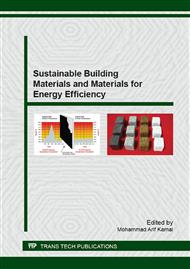[1]
P.K. Mehta: Sulfate attack on concrete - separating myths from reality, Fifth International Conference on Durability of Concrete, Barcelona, Spain; 2000, p.1.
Google Scholar
[2]
R. Tixier, B. Mobasher and M. ASCE: J. Mater. Civ. Eng. ASCE Vol. 15 (2003), p.305.
Google Scholar
[3]
P.J.M. Monteiro and K. E Kurtis: Cem. Concr. Res. Vol. 33 (2003), p.987.
Google Scholar
[4]
S.U. Al-Dulaijan, M. Maslehuddin, M.M. Al-Zahrani, A.M. Sharif, M. Shameem and M. Ibrahim: Cem. Concr. Comp. Vol. 25 (2003), p.429.
DOI: 10.1016/s0958-9465(02)00083-5
Google Scholar
[5]
R. Chihaoui: Durabilité des matériaux cimentaires vis-à-vis d'un environnement chimiquement agressif, Magister thesis, University of sciences and technology of Oran, Algeria (2008).
Google Scholar
[6]
O.S.B. Al-Amoudi, M. Maslehuddin and D.F.H. Rasheeduzzafar: Permeability of concrete-influential factors, In Proceedings of the 4th International conference on deterioration and repair of reinforced concrete, Bahrain, Vol II (1993), p.717.
Google Scholar
[7]
G.I. Sezer, K. Ramyar, B. Karasu, A.B. Göktepe and A. Sezer: Mater. Des. Vol. 29 (2008), p.224.
Google Scholar
[8]
S.U. Al-Dulaijan, D.E. Macphee, M. Maslehuddin, M.M. Al-Zahrani and M.R. Ali: Adv. Cem. Res. Vol 19 (2007), p.167.
Google Scholar
[9]
K.K. Sideris, A.E. Savva and J. Papayianni: Cem. Concr. Compos. Vol. 28 (2006), p.47.
Google Scholar
[10]
R. El-Hachem, E. Rozière, F. Grondin and A. Loukili: Cem. Concr. Res. Vol. 42 (2012), p.1327.
Google Scholar
[11]
M. Ghrici, S. Kenai and M. Said-Mansour: Cem. Concr. Compos. Vol. 29 (2007), p.542.
Google Scholar
[12]
P. J Tikalsky and R. L Carrasquillo: ACI Mater. J. Vol. 89 (1993), p.69.
Google Scholar
[13]
O.S.B. Al-Amoudi: Mechanisms of sulfate attack in plain and blended cements- A review, Proceedings, Performance of Concrete Structures in the Arabian Gulf Environment, KFUPM, Dhahran (1998), p.172.
Google Scholar
[14]
M. Ghrici, S. Kenai, M. Said-Mansour and E. H Kadri: J. Asian Architect. Build. Eng. Vol. 5 (2006), p.349.
Google Scholar
[15]
M. Ghrici, S. Kenai and E. Meziane: J. Mater. Sci. Vol. 41 (2006), p.6965.
Google Scholar
[16]
A. Ali-Aichouba: Effet des pouzzolanes naturelles sur les propriétés d'un ciment à base de calcaire, Mediterranean conference on materials, ENSET Oran, Algeria, 24-25 April (2005).
Google Scholar
[17]
M. Hamadache, M. Mouli, F. Dif, N. Bouhamou and S. Benosman: Adv. Mater. Res. Vol. 1064 (Trans Tech Publications, Switzerland 2015), p.42.
Google Scholar
[18]
H. Siad, S. Kamali-Bernard, H.E. Mesbah, G. Escadeillas, M. Mouli, and H. Khelafi: Constr. Build. Mater. Vol. 47 (2013), p.1188.
DOI: 10.1016/j.conbuildmat.2013.05.086
Google Scholar
[19]
H. Siad, H.A. Mesbah, H. Khelafi, S. Kamali-Bernard and M. Mouli: Arab. J. Sci. Eng. Vol. 35 (2010), p.183.
Google Scholar
[20]
Y. Senhadji, G. Escadeillas, H. Khelafi, M. Mouli and A.S. Benosman: Europ. J. Environ. Civ. Eng. Vol. 16 (2012), p.77.
Google Scholar
[21]
ASTM C1012: American Society for Testing and Materials (ASTM) International, West Conshohocken, Pa (2004).
Google Scholar
[22]
ASTM C305: American Society for Testing and Materials (ASTM) International, West Conshohocken, Pa (1999).
Google Scholar
[23]
ASTM C1437: American Society for Testing and Materials (ASTM) International, West Conshohocken, Pa (2001).
Google Scholar
[24]
ASTM C109/C109M: American Society for Testing and Materials (ASTM) International, West Conshohocken, Pa (2002).
Google Scholar
[25]
T. Aye and C.T. Oguchi: Constr. Build. Mater. Vol. 25 (2011), p.2988.
Google Scholar
[26]
M. Uysal and M. Sumer: Constr. Build. Mater. Vol. 25 (2011), p.4112.
Google Scholar
[27]
S.T. Lee: KSCE J. Civ. Eng. Vol. 16 (2012), pp.601-609.
Google Scholar
[28]
M. Sahmaran, O. Kasap, K. Duru and I.O. Yaman: Cem. Concr. Comp. Vol. 29 (2007), p.159.
Google Scholar
[29]
E.F. Irassar, M. Gonzalez and V. Rahhal: Cem. Concr. Comp. Vol. 22 (2000), p.361.
Google Scholar
[30]
D.F.H. Rasheeduzzafar, O.S.B. Al-Amoudi, S. Abdulfauwad and M. Maslehuddin: J. Mater. Civ. Eng. Vol. 6 (1994), p.201.
Google Scholar
[31]
M.F. Montemor, A.M.P. Simoes and M.M. Salta: Cem. Concr. Comp. Vol. 22 (2000), p.175.
Google Scholar


